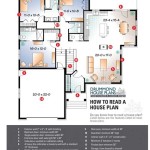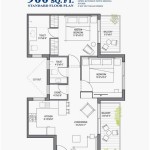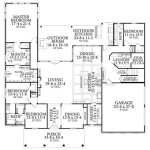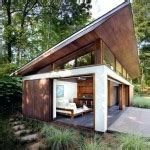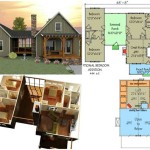A house floor plan serves as a blueprint for designing and constructing a residential building. It outlines the layout, arrangement, and dimensions of various rooms, walls, and other architectural features within a house. Floor plans provide a visual representation of the spatial relationships between different areas and help visualize the flow of movement throughout the building.
Creating a well-designed house floor plan is an essential step in the home-building process. It allows architects, designers, and homeowners to plan the functionality, aesthetics, and overall livability of the house. A well-thought-out floor plan can optimize space utilization, improve natural light distribution, enhance the flow of traffic, and create a comfortable and inviting living environment.
In this article, we will delve into the key considerations and steps involved in designing a comprehensive house floor plan. We will explore the different types of floor plans, discuss the essential elements to include, and provide practical tips and insights to help you create a functional and aesthetically pleasing layout for your dream home.
When designing a house floor plan, there are several key points to consider to ensure functionality, livability, and aesthetic appeal.
- Define room sizes
- Plan for traffic flow
- Maximize natural light
- Consider future needs
- Prioritize energy efficiency
- Incorporate storage spaces
- Design for accessibility
- Seek professional advice
By carefully considering these points and following a structured approach, you can create a house floor plan that meets your specific needs and aspirations.
Define room sizes
Determining the appropriate size for each room in your house is crucial for creating a functional and comfortable living space. The size of a room should be proportionate to its intended use and the number of people who will be using it. Here are some key considerations when defining room sizes:
Function: The primary function of a room will dictate its minimum size. For example, a bedroom should be large enough to accommodate a bed, dresser, and nightstand, while a living room should be large enough to accommodate seating for guests and allow for comfortable movement. Consider the activities that will take place in each room and ensure that the size is adequate for those activities.
Furniture: The size and arrangement of furniture will also impact the size of a room. Measure your furniture or plan the layout in advance to ensure that there is enough space for furniture and circulation. Avoid overcrowding rooms with too much furniture, as this can make them feel cramped and uncomfortable.
Flow and circulation: The flow of traffic through a house is important for both functionality and safety. Ensure that there is enough space between furniture and walls to allow for easy movement. Consider the placement of doors and windows to avoid creating bottlenecks or awkward traffic patterns.
Natural light: Natural light can make a room feel more spacious and inviting. When determining room sizes, consider the placement of windows and doors to maximize natural light. Avoid designing rooms that are too dark or lack windows, as this can make them feel cramped and unwelcoming.
Plan for traffic flow
Planning for traffic flow is essential for creating a functional and comfortable home. Good traffic flow allows people to move easily and safely throughout the house without feeling cramped or obstructed. Here are some key considerations for planning traffic flow:
- Minimize bottlenecks: Avoid creating narrow hallways or doorways that can cause congestion. Ensure that there is enough space for people to pass each other comfortably.
- Create a central gathering space: A central gathering space, such as a living room or family room, can help to improve traffic flow by providing a central point for people to gather and move around.
- Separate public and private spaces: Public spaces, such as the living room and dining room, should be easily accessible from the entryway. Private spaces, such as bedrooms and bathrooms, should be located in a more secluded area of the house.
- Consider circulation patterns: Think about how people will move through the house on a daily basis. For example, the kitchen should be easily accessible from the dining room and living room, and the bedrooms should be easily accessible from the bathrooms.
By carefully planning for traffic flow, you can create a home that is both functional and inviting.
Maximize natural light
Natural light can make a room feel more spacious, inviting, and healthy. It can also reduce the need for artificial lighting, saving energy. Here are some key considerations for maximizing natural light in your house floor plan:
Window placement: The placement of windows is critical for maximizing natural light. Place windows on the south side of the house to take advantage of the sun’s path. Avoid placing windows on the north side of the house, as this will result in less natural light. Consider the size and shape of windows as well. Larger windows will allow more light into a room, and windows that are placed high on a wall will allow light to penetrate deeper into the room.
Skylights: Skylights are a great way to add natural light to a room that doesn’t have many windows. Skylights can be placed in any room of the house, but they are particularly effective in bathrooms, kitchens, and hallways. Consider the size and placement of skylights to ensure that they provide adequate light without creating glare or overheating.
Light-colored surfaces: Light-colored surfaces reflect more light than dark-colored surfaces. This means that painting your walls and ceilings a light color can help to brighten up a room. You can also use light-colored furniture and fabrics to reflect more light.
Avoid obstructions: Avoid placing furniture or other objects in front of windows or skylights, as this will block natural light. If you must place furniture in front of a window, choose pieces that are low and narrow so that they don’t obstruct too much light.
By following these tips, you can maximize natural light in your house floor plan and create a more inviting and healthy living environment.
Consider future needs
When designing your house floor plan, it is important to consider your future needs as well as your current needs. This means thinking about how your lifestyle may change over time and how your house can accommodate those changes.
For example, if you are planning to have children in the future, you may want to design your house with an extra bedroom or two. If you are planning to retire in your home, you may want to design your house with a first-floor master suite and accessible features.
It is also important to consider your long-term financial goals. If you are planning to sell your house in the future, you will want to design a house that is appealing to a wide range of buyers. This means avoiding overly specific design choices and opting for more classic and timeless styles.
By considering your future needs, you can design a house that will meet your needs for many years to come.
Prioritize energy efficiency
Prioritizing energy efficiency in your house floor plan can save you money on your energy bills and reduce your environmental impact. Here are some key considerations for designing an energy-efficient house:
Insulation: Insulation is one of the most important factors in reducing heat loss and gain. Choose insulation with a high R-value, which measures its resistance to heat flow. The higher the R-value, the better the insulation. Install insulation in the walls, ceiling, and floor to create a thermal envelope around your house.
Windows and doors: Windows and doors are another major source of heat loss and gain. Choose energy-efficient windows and doors with high R-values and low U-factors. U-factor measures the rate of heat transfer through a window or door, so a lower U-factor indicates better insulation.
Air sealing: Air sealing is the process of sealing any cracks or gaps in your house’s envelope where air can leak in or out. Air leaks can significantly increase your energy bills, so it is important to seal them carefully. Use caulk, weatherstripping, and other materials to seal any gaps around windows, doors, pipes, and other openings.
Appliances: When choosing appliances, look for models with the Energy Star label. Energy Star appliances are independently certified to meet strict energy efficiency standards. By choosing Energy Star appliances, you can save money on your energy bills and reduce your environmental impact.
By following these tips, you can prioritize energy efficiency in your house floor plan and create a more sustainable and comfortable home.
Incorporate storage spaces
Incorporating adequate storage spaces into your house floor plan is essential for maintaining a well-organized and clutter-free home. Here are some key considerations for designing a house with ample storage:
Plan for different types of storage: Different types of storage are suitable for different items. For example, you may need shelves for books and dcor, drawers for clothes and linens, and cabinets for kitchenware and cleaning supplies. Consider the types of items you will need to store and plan for a variety of storage options.
Maximize vertical space: Vertical space is often overlooked when it comes to storage. However, it can be a valuable asset, especially in smaller homes. Use shelves, cabinets, and drawers that extend to the ceiling to maximize vertical space and store more items.
Utilize hidden storage: Hidden storage can be a great way to keep clutter out of sight. Consider incorporating hidden storage into your furniture, such as ottomans with built-in storage or beds with drawers underneath. You can also use baskets and bins to store items under beds or in closets.
Don’t forget about outdoor storage: Outdoor storage can be just as important as indoor storage, especially if you have a lot of seasonal items or equipment. Consider adding a shed, garage, or other outdoor storage space to your property.
By incorporating ample storage spaces into your house floor plan, you can create a more organized and functional home that meets your needs.
Design for accessibility
Designing for accessibility is essential for creating a home that is safe, comfortable, and enjoyable for everyone, regardless of their age or ability. Here are some key considerations for designing an accessible house floor plan:
- Wide doorways and hallways: Wide doorways and hallways allow for easy movement of wheelchairs, walkers, and other mobility aids. Aim for a minimum width of 36 inches for doorways and 42 inches for hallways.
- Accessible bathrooms: Accessible bathrooms include features such as roll-in showers, grab bars, and raised toilets. These features make it easier for people with mobility impairments to use the bathroom safely and independently.
- Main-floor bedroom and bathroom: Having a bedroom and bathroom on the main floor of the house can be beneficial for people with mobility impairments or who may have difficulty using stairs. This allows them to live independently without having to navigate stairs.
- Ramps and elevators: For houses with multiple floors, ramps and elevators can provide accessible access to all levels of the house. Ramps should have a gentle slope and be wide enough for wheelchairs to pass comfortably.
By incorporating these accessibility features into your house floor plan, you can create a home that is welcoming and comfortable for everyone.
Seek professional advice
While it is possible to design a house floor plan on your own, it is often advisable to seek professional advice from an architect or designer. A professional can help you to create a floor plan that meets your specific needs and requirements, and can also help you to avoid costly mistakes.
Here are some of the benefits of seeking professional advice when designing a house floor plan:
- Expertise and experience: Architects and designers have the expertise and experience to create floor plans that are functional, efficient, and aesthetically pleasing. They can help you to make the most of your space and to create a home that meets your unique needs.
- Code compliance: Architects and designers are familiar with building codes and regulations, and can help you to ensure that your floor plan complies with all applicable requirements. This can save you time and money in the long run.
- Objectivity: A professional can provide an objective perspective on your floor plan, and can help you to identify areas that could be improved. They can also help you to avoid making emotional decisions that could compromise the functionality or aesthetics of your home.
- Peace of mind: Knowing that your floor plan has been designed by a professional can give you peace of mind. You can be confident that your home will be built to a high standard and that it will meet your needs and expectations.
If you are considering designing a house, it is highly recommended that you seek professional advice from an architect or designer. A professional can help you to create a floor plan that meets your specific needs and requirements, and can also help you to avoid costly mistakes.



:max_bytes(150000):strip_icc()/floorplan-138720186-crop2-58a876a55f9b58a3c99f3d35.jpg)






Related Posts


